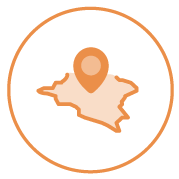Engaging
Early and
Meaningfully
How Rio Tinto’s Sulawesi project has changed their corporate social responsibility in the mining industry
Main challenge
Operating in a multiethnic context where it is hard to identify local groups due to high level of migration in the area, remote access to site due to poor infrastructure, identifying broader needs of silent majority versus vocal elite.
The project
Over the past two decades, consultation and disclosure in the extractive industry have changed from a short-term means of meeting regulatory and lender requirements to longer-term strategic relationship-building. Continuous stakeholder engagement results in a vast amount of very important information captured ‘in the heads’ of staff in government relations, community relations, contractor management. The Boréalis application is assisting us in making this knowledge more accessible to the company by linking people, departments, locations, meetings, and more together. This allows us to better document, analyze, and communicate the complexities coming with continuous stakeholder engagement.
Dr Stephan Lorenzen - Corporate Compliance Coordinator for the Sulawesi Nickel Project
Solutions
Using the Boréalis application as a centralized database of all community engagements, social baseline data, and other key factors. The whole management team was trained in using Boréalis, included in solution finding, and aware of situations in communities at all times.
Reserves estimates at
162 megatons of nickel (1.6%)
Original exploration
concession of
44,067 hectares
Greenfield project: baseline and
community relations
strategies were established before exploration
Joint venture
of Rio Tinto and Sherritt International
Socio-economic and cultural heritage baseline started in March
2009
and exploration began in December 20011
Outcomes
- No complaints for project from 2009 to 2014
- Inclusive company/community solution finding process (involving management level)
- Better resource allocation
- Identification of influencers and risk areas
- Formalisation of engagement with communities (institutional memory)
- Compliance to international standards (IFC)
Multiethnic contact in an area with lots of migration and power shifts
Identifying influencers, loud minorities and silent majorities
Local communities are always heterogeneous and political. Identifying and understanding the different interests in, and different influences on the project is crucial. Community relations officers were trained in the field to focus on the communities as a whole in order to avoid engaging with the local elite only. Who are high interest, with no influence –marginal groups? Who has political power vs. who has economic power? How are these power relations organized?
Making engagements with communities formal
Local communities are very dynamic and have little formal regulations and agreements. This is a challenge for companies, which need to predict and manage project risks. There are no contracts and the majority of agreements are verbal. Companies are made the opposite way: to operate they need to be able to manage risk by increasing predictability. The CROs are often in a situation where they have to translate informal agreements into formal ones without overcommitting. The Boréalis Stakeholder Engagement module with records for both informal and formal meetings assisted this process.
Boréalis: The solution
The Sulawesi project had the advantage that community engagement started one year before exploration as part of the socioeconomic and cultural heritage baseline. With Boréalis’ Stakeholder Engagement and Social Baseline modules, information about all engagement activities was well documented and easy to find. Implementing good CSR practices early on allowed PT Sulawesi Cahaya Mineral to be compliant with IFC performance standards and to build strong relations with the local community. This resulted in the social license to operate. Management could access information that is usually only available to field staff and improved communication between generated an effective ‘early warning system’ for community/company issues. It became a pro-active approach to participatory solution finding.
Fair local employment benefits
The local community had high expectations related to employment opportunities and anticipated fear of opportunistic in-migration. They worked closely with the communities to identify several criteria (regulatory, geographic, kinship and temporal) that defined who was considered ‘local’ according to the local community. People with corresponding profiles (verified by democratically elected village and subdistrict committees) were added to the “local peoples pool” and registered in the Stakeholder Engagement module.
Through the Boréalis application, the company was able to equally distribute local employment across all 9 local villages. From the start of exploration SCM had 75% local employment across the whole company and contractors. The employment statistics (positions, departments, etc.) were transparent and monitored by village and sub-district committees.
Zero grievance since day once
Customized community development
Better, strengthened decision-making
The Boréalis application became the main communication tool for the project and was used by both field teams and management. Through their close relationship with the communities, the CROs (who spent 80% of their time in the field) always had «their hand on the communities’ pulse» and work toward solutions on all levels that concerned the community. Because tasks were assigned to the various staff, including geologists and engineers, all employees were accountable for their actions. They used the Boréalis application to document and communicate the different departments’ stakeholder engagement activities, including continuous improvement across the activities.

Inspired by this great success story?
Start writing yours today!







